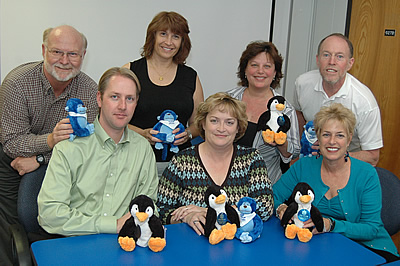| Helping
Teachers Teach Math |
|||||
|
|||||
|
December 1, 2005 Three years ago, a group of Cal State Fullerton professors gathered to figure out how to help middle school teachers teach algebra and other math concepts to their students. The result is an online program, PD-ROM (Professional Development Resources Online for Mathematics), that provides math instruction with concrete ideas on how to best convey these topics to students. “All high school students are now required to pass an exit exam that is based on concepts and skills presented in middle school mathematics, including algebra. There are many students who will complete high school this spring without passing this test, and school districts are looking for ways to improve student achievement,” said Victoria B. Costa, chair and professor of secondary education and one of the principals of the group. The problems, Costa notes, are two-fold. Some middle school math teachers have gaps in their knowledge and skills in algebra and geometry. For that reason, there may be topics in the curriculum for which they don’t have a sufficient background. This makes it difficult for them to foresee difficulties students will have. PD-ROM is designed to fill in those gaps. The other problem is that some teachers who have excellent math skills aren’t always the most effective at getting the information across to the students, said Costa. “The state has recognized that math skills are essential to education,” said Martin V. Bonsangue, professor of mathematics. “And who better to ‘teach the teachers’ than a combination of math and education professors.” The group that developed PD-ROM — which also consists of Harris S. Shultz, professor of mathematics, and Sandra Lapham, administrator of instructional services for the Orange County Department of Education — recognized that since teachers are in classrooms for the better part of the day, a traditional approach to professional development may not work. “An online program made sense from a variety of perspectives,” said Costa. “First, teachers could do the work when it was convenient for them. They don’t have to sit in front of their computers at a specific time on a specific day. They could fit this program in around their existing schedules. In addition, they could explore the increasing variety of Web-based instructional resources available to improve teaching and learning.” Interaction with colleagues also is valuable, so when teachers enroll each semester, they are part of a “cohort” that moves from session to session with one another. One of the key elements of the program was to ensure that the professional development experience had practical applications in the classroom. In developing the curriculum, the team looked at some of the questions that were missed most frequently in the state high school exit exams. “What we discovered is that some of the questions on the exam never appear in school textbooks,” said Costa. “For example, students learn how to follow the order of operations with integers, and they learn how to add and subtract fractions. However, they do not practice how to use the order of operations when adding and subtracting fractions. The result is that over 65 percent of students miss such a problem on the examination. Many of the problems on the high school exit examinations have this similar multi-step, multi-concept complexity.” To help teachers address these gaps in instruction and make links between mathematical concepts, actual math teachers were filmed in the classroom teaching concepts associated with multi-step, multi-concept mathematics problems. “Teachers see the relevance of the classes,” said Bonsangue. “There are techniques that they can apply in the classroom almost immediately.” Currently the program has enrolled teachers from
Orange, Los Angeles, Monterey and Riverside counties. Beginning
in mid-October, the PD-ROM organizers began working with students
working toward teaching credentials. |
|
